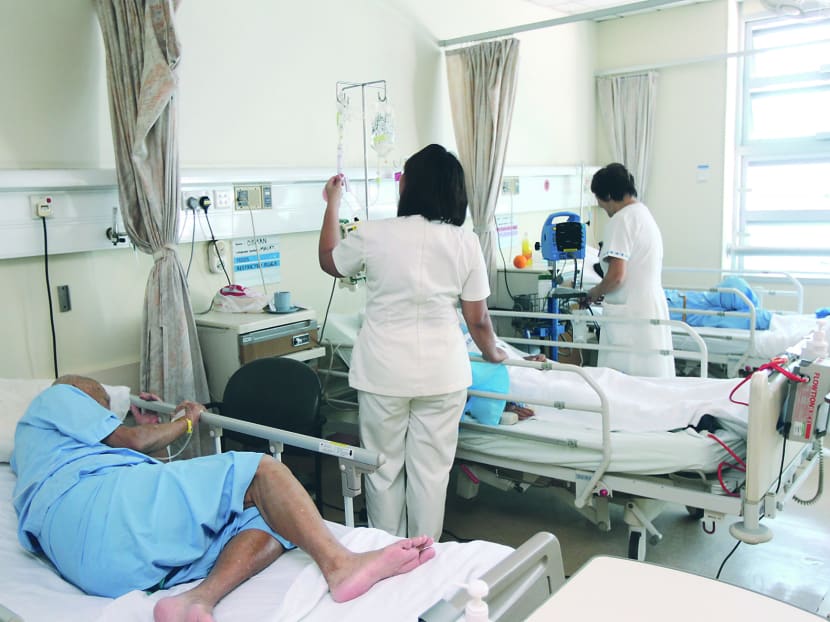83,000 may need help with daily living by 2030
SINGAPORE — More human and infrastructural support will be needed by older Singaporeans in the next two decades, say researchers who have provided future estimates of those who would require a helping hand with everyday rituals for the first time.
SINGAPORE — More human and infrastructural support will be needed by older Singaporeans in the next two decades, say researchers who have provided future estimates of those who would require a helping hand with everyday rituals for the first time.
Not only will their absolute numbers rise as the nation’s population ages, the proportion of elderly who require someone to help with a greater number of daily activities is expected to grow.
This is because such limitations tend to accumulate with age and the number of those aged above 70 is set to increase. The figures through 2030 will help policymakers plan for acute and long-term care services to meet future demand here, the researchers say.
Singapore will be home to about 1.17 million citizens and permanent residents aged 60 and above in 2030, and about 7 per cent of them — or 82,968 individuals — will need help with dressing, eating, going to the toilet or any other activity of daily living (ADL), according to the study. This is about two-and-a-half times the 31,738 older folk estimated in 2010 who needed help with at least one ADL.
More women than men are expected to make up this group due to the greater life expectancy of women and the greater prevalence of non-fatal disabling health conditions among them.
More than half of these individuals will have difficulty with three or more ADLs — 53.2 per cent by 2030, up from 52.7 per cent in 2010 — projected the study, published in the Academy of Medicine Singapore’s January issue of ANNALS.
The projections were primarily based on the prevalence of seniors with ADL limitations requiring human assistance found in a 2009 survey on social isolation, health and lifestyles of 5,000 elderly living in the community.
The researchers used 2010 population census data, held birth and mortality rates constant, and took into account the prevalence of ADL limitations among older residents in nursing homes based on a previous study.
The simulations, initiated in 2012 before the Population White Paper was released last year, assume a population of 6.5 million by 2050. They are thus unlikely to be an overestimate, said Assistant Professor Rahul Malhotra of Duke-NUS Graduate Medical School, one of the authors.
PLANNING FOR THE LONG TERM
If the numbers of those with multiple ADL limitations increase as projected, formal care providers such as nursing homes will see a greater need for resource-intensive round-the-clock care, and family caregivers could be putting in more hours and will need to be better-prepared, said the authors.
More elderly would also be eligible for schemes such as ElderShield, a severe disability insurance scheme covering those from age 40 who are unable to do three or more of the six ADLs.
The authors could not comment on how much the capacity of eldercare facilities and services should expand by 2030, due to the lack of public information on the current capacity and distribution of elderly with ADL limitations in these services, they said.
Many factors will affect future demand and some care options could become less attractive. “Also, there is some recent evidence that progression of disability is changing, perhaps due to improvements in infrastructure and education,” they said.
For Associate Professor Goh Lee Gan, President of the Gerontological Society of Singapore, prevention is key. The public should try to prevent disability resulting from chronic diseases by avoiding overeating, smoking, obesity and a sedentary lifestyle.
“As much as 50 per cent of people will die prematurely or will be disabled to some degree. How many people realise this? So the answer is prevention, prevention, prevention,” he said.
Warding off falls and dementia is also important: The first requires safety at home and judicious use of drugs, and for the latter, social engagement and a rethink of the retirement age.
Assoc Prof Goh, who is not among the study’s authors, also advocated integrated care and said family doctors need to be better paid to take on this role.
To carry out capacity planning, further studies can be done on the effectiveness of getting people to adopt preventive behaviour, as well as the impact of integration of care on re-admission rates and in reducing further disability, he said.







